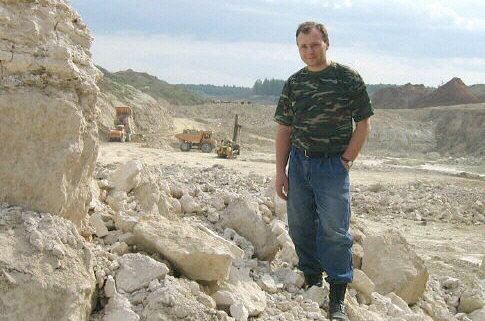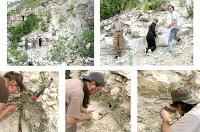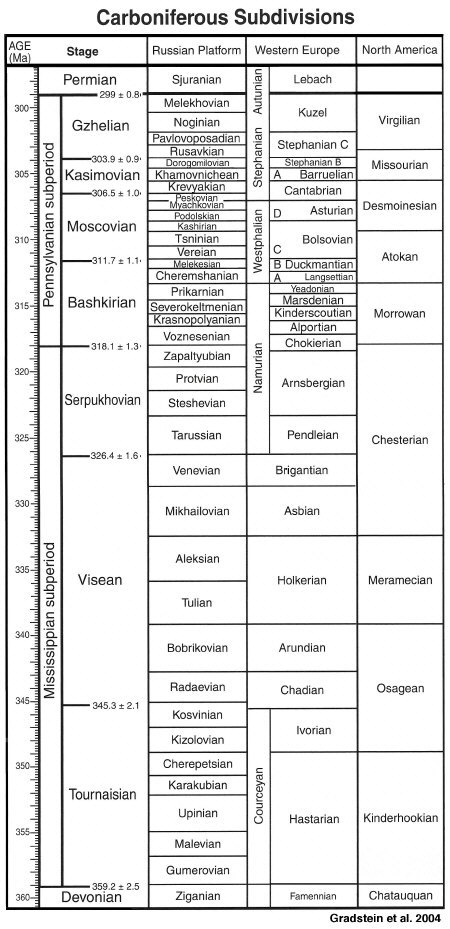
Produced by: Barry Sutton, Alexander Davydov and Tom Yancey
This website is presented to showcase Carboniferous
fossils of the
Moscow region of Russia; an area that is world famous for beautifully
preserved fossils. This website provides an opportunity to see fossils
of those deposits that are poorly known outside Russia or have not
been illustrated with high quality photos. Some of the Late Carboniferous
(Pennsylvanian) fossils occur in both the Moscow region and in the
American midcontinent.
The fossils shown here are grouped by geologic stage,
illustrated on
the chart below. This shows the international stages of the Carboniferous
and the regional stages for Russia, west Europe and North America.
Site
Search Engine
Search Carbonifierous fossils of Russia or the Web
Pennsylvanian fossils
Gzhel quarry, Gzhel village
 Gzhelian
Stage, Rusavkian substage
Gzhelian
Stage, Rusavkian substage

Mississippian fossils
 Visean
Stage, Aleksian-Mikhailovian substages
Visean
Stage, Aleksian-Mikhailovian substages
Identifications:
The fossils illustrated here are identified as accurately as possible by
the web producers and in most cases represent the genus and species
names used for these fossils in most of the paleontological literature.
Only the brachiopods and molluscs have been carefully checked, but
names of fossils in other groups are identified to species if they are
common and well known. In some cases details of internal structures
are needed to determine identity of the taxon and if this is not known
for these specimens, it is noted in the comments. Some species in the
biota have not been illustrated if their identity is unknown or questionable
All species illustrated are macrofauna or species large enough to be
easily seen. References to species descriptions are given where
appropriate, especially if an English language description is available.
Mystery Fossil
Trace Fossils
Photojournal
report on a fossil hunt in Russia
Click on the Chart to magnify
Carboniferous Subdivisions chart
Introduction and History of development of the web site
This web site is presented as a vehicle to provide
documentation of
some important fossil sites and to provide an educational resource
for persons wanting to know more about late Carboniferous fossils.
The web site is the responsibility of Mr. Barry Sutton, Dr. Tom Yancey
and Dr. Alexander Davydov (M. D.)
Good illustrations of species are required for good identifications
of fossils and the Lake Neosho web site has gained popularity for
quality illustrations along with an informal means for sharing information
on fossils. On December 11, 2006, Dr. Alexander Davydov of Moscow,
Russia, contacted me (Barry Sutton) to open a dialog for comparing
photos and information regarding fossils that I collected in the USA
and comparing them with fossils he collected in Russia. We decided
to share resources on web-based illustrations and develop a joint
venture to present photos of these fossils.
Limestones of the Moscow basin tend to be softer than
Carboniferous
limestones of other regions and some of the Moscow units are more
like marls. The sediment is less cemented and it is easier to
separate the fossils from the sediment matrix. The finer grained
matrix and lesser cementation also allow more groundwater to move
through the sediment and the result is that some layers acquire a
yellowish color tint from a light coating of iron oxides. However,
even in these sediments, silica from opaline skeletons (sponge
spicules) dissolves and some beds contain silicified fossils.
This is meant to be an interactive resource and is
intended to serve
all who are interested in these fossils. Comments from viewers are
invited that relate to the fossils shown, including observations on
characters of the fossils or encrusters and thoughts about probable
life habits. For some species, identification is tentative and
comments on possible relationship are welcome if they help
in identification.
Launching this website was made possible solely
through the effort of
three people:
Dr. Alexander Davydov, M. D., whose work in
collecting, identifying
and illustrating fossils of the Moscow region has provided an opportunity
to share these excellent specimens with others and who has worked with
Russian geoscientists to provide accurate data.
Mr. Barry Sutton, amateur paleontologist, whose
hand and his sense
of style shaped the way the information was processed and represented.
In addition, he provided the server space and technical support for the
project through offering the website format for fossil representation.
Dr. Thomas Yancey, professor, who works on the scientific
content
of the site, analysis and selection of the material to be presented.
Special thanks to Mike Sevastopolskiy for volunteering his
time and expertise as Russian interpreter.
Dr. Yuri V. Yashunsky has helped describe the stratigraphic section
at the Gzhel quarry and has been part of collecting expeditions to
document the Gzhelian fossil biota.
Link Menu
Russia-USA
joint venture Paleontology project
Language separates us ... Pictures bring us together
Alexander Davydov (Moscow, Russia)
Barry Sutton (St. Louis, Missouri - USA)
Jurassic.ru
(English text) Jurassic.ru
(Russian text)
This site is about the Jurassic of Russia and adjacent areas.
Publications, history and present-day information on the
Jurassic of Russia.
Other LakeNeosho.org projects
Paleontology and Geology of Missouri
(home page)
St. Louis Pennsylvanian
Fossils of the Altamont Formation (I-170 Exposure)
The I-170 Pennsylvanian Exposure
in St. Louis, Missouri
Mississippian Fossils
of Missouri
Other Fossils (USA and World
Wide)
Copyright
© All rights reserved
The Pictures on this web site
are the sole and personal property
of Dr. Alexander Davydov and Barry Sutton.
© All rights reserved
Contact:
Barry Sutton and Alexander Davydov
Russia@LakeNeosho.org
Top of Page

